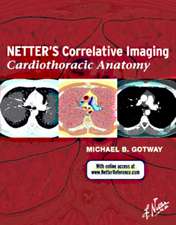The Story of the Human Body: Evolution, Health, and Disease
Autor Daniel E. Liebermanen Limba Engleză Paperback – 30 iun 2014
With charts and line drawings throughout.]"
Preț: 104.62 lei
Preț vechi: 110.12 lei
-5% Nou
Puncte Express: 157
Preț estimativ în valută:
20.02€ • 21.05$ • 16.54£
20.02€ • 21.05$ • 16.54£
Carte disponibilă
Livrare economică 26 martie-09 aprilie
Preluare comenzi: 021 569.72.76
Specificații
ISBN-13: 9780307741806
ISBN-10: 030774180X
Pagini: 460
Dimensiuni: 128 x 205 x 18 mm
Greutate: 0.44 kg
Editura: VINTAGE BOOKS
Locul publicării:New York, United States
ISBN-10: 030774180X
Pagini: 460
Dimensiuni: 128 x 205 x 18 mm
Greutate: 0.44 kg
Editura: VINTAGE BOOKS
Locul publicării:New York, United States
Recenzii
"No one understands the human body like Daniel Lieberman or tells its story more eloquently. He's found a tale inside our skin that's riveting, enlightening, and more than a little frightening."
--Christopher McDougall, author of "Born to Run"
"Monumental: "The Story of the Human Body," by one of our leading experts, takes us on an epic voyage that reveals how the past six million years shaped every part of us--our heads, limbs, and even our metabolism. Through Lieberman's eyes, evolutionary history not only comes alive, it becomes the means to understand, and ultimately influence, our body's future."
--Neil Shubin, author of "Your Inner Fish"
"These are not debates to gloss over or reduce to simple statements of cause and effect -- they are stories with scientific complexity and tremendous, sometimes contradictory accumulations of evidence and detail. "The Story of the Human Body" does full justice to those stories, to that evidence and to that detail, and brings them to bear on daily health and well-being, individual and collective.
--"Washington Post
"
"[Lieberman] is a true expert in a system where architecture and history intersect: the human foot. He ably describes how behavior and anatomy can lead to foot injuries in long-distance runners."
--"Wall Street Journal"
"In thoughtful, lucid prose backed up by a hard-to-fathom amount of research, Lieberman gives us the language to understand the history of our ancestors--the history that lives on in our minds and in our bodies . . . "The Story of the Human Body," expertly researched and told in an original voice, will make you look at your own body more critically--and perhaps treat it with a little more respect. After all, we sit at the edge of millions of years of small refinements that stretched this part and shortened that piece. Lieberman shows how it all fits together and that it was no accident."
--"Everyday eBook"
"Eloquent and precise . . . Lieberman is th
"Monumental . . . an epic voyage that reveals how the past six million years shaped every part of us--our heads, limbs, and even our metabolism. . . . Through Lieberman's eyes, evolutionary history not only comes alive, it becomes the means to understand, and ultimately influence, our body's future."
--Neil Shubin, author of "Your Inner Fish"
"Fascinating. . . . A readable introduction to the whole field and great on the making of our physicality."
--"Nature "
"Sweeping. . . . Convincingly makes the case for a wholesale rethinking of how we live our modern lives.'"
--"CommonHealth," WBUR
"Riveting, enlightening, and more than a little frightening. . . . No one understands the human body like Daniel Lieberman or tells its story more eloquently."
--Christopher McDougall, author of "Born to Run"
"These are not debates to gloss over or reduce to simple statements of cause and effect--they are stories with scientific complexity and tremendous, sometimes contradictory accumulations of evidence and detail. "The Story of the Human Body "does full justice to those stories, to that evidence and to that detail, and brings them to bear on daily health and well-being, individual and collective."
--"The Washington Post"
"[Lieberman] is a true expert in a system where architecture and history intersect: the human foot. He ably describes how behavior and anatomy can lead to foot injuries in long-distance runners."
--"The Wall Street Journal"
"The ultimate science-based Paleo investigation. . . . Convincing. . . . A great read, and I recommend it highly for those of you who are interested in learning the facts about our biological roots, and how we can rationally apply 'Paleo' concepts to prevent and reverse modern 'mismatch' diseases."
--Dr. Ronald Hoffman, The Hoffman Center/"Health Talk"
"Eloquent and precise . . . Lieberman is the first to point out that modern living and technology have made our lives better in many ways. Still, a look back at where we came from can tell us a lot about where we're headed, he says--and how we might alter that course for the better."
--"Grist"
"A doozy. . . . That humans are poorly adapted to our modern lifestyle of convenience foods, flat screens, and desk jobs isn't very controversial. But how we best cope with this new reality often is. Lieberman takes on many popular notions, including barefoot running, the paleo diet, epigenetics, and a host of hot topics ranging from obesity and chronic disease to Nanny State politics."
--"Outside"
"[Lieberman's] evolutionary approach produces some counterintuitive surprises. . . . "The Story of the Human Body" is a reliable guide to a problem that is going to get worse before it gets better."
--"The Guardian"
"In thoroughly enjoyable and edifying prose, Lieberman . . . leads a fascinating journey through human evolution. He comprehensively explains how evolutionary forces have shaped the human species as we know it. . . . He balances a historical perspective with a contemporary one . . . while asking how we might control the destiny of our species. He argues persuasively that 'cultural evolution is now the dominant force of evolutionary change acting on the human body.'"
--"Publishers Weekly" (starred review)
"Lieberman gracefully combines paleontology, anatomy, physiology, and experimental biomechanics to clarify how the human body has evolved and how evolutionary design now clashes with the particularities of modern society. . . . An important book."
--"Library Journal"
"Lieberman holds nothing back. . . . He cleverly and comprehensively points out the perils of possessing Paleolithic anatomy and physiology in a modern world and bemoans 'just how out of touch we have become with our bodies.'. . . If we want to continue our phenomenal run as a species, it is essential to understand (and embrace) our evolutionary legacy."
--"Booklist"
"A massive review of where we came from and what ails us now . . . Would that industry and governments take heed."
"--Kirkus Reviews"
--Christopher McDougall, author of "Born to Run"
"Monumental: "The Story of the Human Body," by one of our leading experts, takes us on an epic voyage that reveals how the past six million years shaped every part of us--our heads, limbs, and even our metabolism. Through Lieberman's eyes, evolutionary history not only comes alive, it becomes the means to understand, and ultimately influence, our body's future."
--Neil Shubin, author of "Your Inner Fish"
"These are not debates to gloss over or reduce to simple statements of cause and effect -- they are stories with scientific complexity and tremendous, sometimes contradictory accumulations of evidence and detail. "The Story of the Human Body" does full justice to those stories, to that evidence and to that detail, and brings them to bear on daily health and well-being, individual and collective.
--"Washington Post
"
"[Lieberman] is a true expert in a system where architecture and history intersect: the human foot. He ably describes how behavior and anatomy can lead to foot injuries in long-distance runners."
--"Wall Street Journal"
"In thoughtful, lucid prose backed up by a hard-to-fathom amount of research, Lieberman gives us the language to understand the history of our ancestors--the history that lives on in our minds and in our bodies . . . "The Story of the Human Body," expertly researched and told in an original voice, will make you look at your own body more critically--and perhaps treat it with a little more respect. After all, we sit at the edge of millions of years of small refinements that stretched this part and shortened that piece. Lieberman shows how it all fits together and that it was no accident."
--"Everyday eBook"
"Eloquent and precise . . . Lieberman is th
"Monumental . . . an epic voyage that reveals how the past six million years shaped every part of us--our heads, limbs, and even our metabolism. . . . Through Lieberman's eyes, evolutionary history not only comes alive, it becomes the means to understand, and ultimately influence, our body's future."
--Neil Shubin, author of "Your Inner Fish"
"Fascinating. . . . A readable introduction to the whole field and great on the making of our physicality."
--"Nature "
"Sweeping. . . . Convincingly makes the case for a wholesale rethinking of how we live our modern lives.'"
--"CommonHealth," WBUR
"Riveting, enlightening, and more than a little frightening. . . . No one understands the human body like Daniel Lieberman or tells its story more eloquently."
--Christopher McDougall, author of "Born to Run"
"These are not debates to gloss over or reduce to simple statements of cause and effect--they are stories with scientific complexity and tremendous, sometimes contradictory accumulations of evidence and detail. "The Story of the Human Body "does full justice to those stories, to that evidence and to that detail, and brings them to bear on daily health and well-being, individual and collective."
--"The Washington Post"
"[Lieberman] is a true expert in a system where architecture and history intersect: the human foot. He ably describes how behavior and anatomy can lead to foot injuries in long-distance runners."
--"The Wall Street Journal"
"The ultimate science-based Paleo investigation. . . . Convincing. . . . A great read, and I recommend it highly for those of you who are interested in learning the facts about our biological roots, and how we can rationally apply 'Paleo' concepts to prevent and reverse modern 'mismatch' diseases."
--Dr. Ronald Hoffman, The Hoffman Center/"Health Talk"
"Eloquent and precise . . . Lieberman is the first to point out that modern living and technology have made our lives better in many ways. Still, a look back at where we came from can tell us a lot about where we're headed, he says--and how we might alter that course for the better."
--"Grist"
"A doozy. . . . That humans are poorly adapted to our modern lifestyle of convenience foods, flat screens, and desk jobs isn't very controversial. But how we best cope with this new reality often is. Lieberman takes on many popular notions, including barefoot running, the paleo diet, epigenetics, and a host of hot topics ranging from obesity and chronic disease to Nanny State politics."
--"Outside"
"[Lieberman's] evolutionary approach produces some counterintuitive surprises. . . . "The Story of the Human Body" is a reliable guide to a problem that is going to get worse before it gets better."
--"The Guardian"
"In thoroughly enjoyable and edifying prose, Lieberman . . . leads a fascinating journey through human evolution. He comprehensively explains how evolutionary forces have shaped the human species as we know it. . . . He balances a historical perspective with a contemporary one . . . while asking how we might control the destiny of our species. He argues persuasively that 'cultural evolution is now the dominant force of evolutionary change acting on the human body.'"
--"Publishers Weekly" (starred review)
"Lieberman gracefully combines paleontology, anatomy, physiology, and experimental biomechanics to clarify how the human body has evolved and how evolutionary design now clashes with the particularities of modern society. . . . An important book."
--"Library Journal"
"Lieberman holds nothing back. . . . He cleverly and comprehensively points out the perils of possessing Paleolithic anatomy and physiology in a modern world and bemoans 'just how out of touch we have become with our bodies.'. . . If we want to continue our phenomenal run as a species, it is essential to understand (and embrace) our evolutionary legacy."
--"Booklist"
"A massive review of where we came from and what ails us now . . . Would that industry and governments take heed."
"--Kirkus Reviews"
Notă biografică
Daniel E. Lieberman is professor of human evolutionary biology and the Edwin M. Lerner II Professor of Biological Sciences at Harvard. He has written more than one hundred articles, many appearing in the journals "Nature "and "Science. "Lieberman is especially well known for his research on the evolution of the human head and the evolution of running, including barefoot running (earning him the nickname the Barefoot Professor). His research and discoveries have been highlighted widely in newspapers, magazines, books, news programs, and documentaries.
Descriere
In this landmark book of popular science, Daniel E. Lieberman gives us a lucid and engaging account of how the human body evolved over millions of years. He illuminates the major transformations that contributed to key adaptations to the body: the rise of bipedalism; the shift to a non-fruit-based diet; the advent of hunting and gathering; and how cultural changes like the Agricultural and Industrial Revolutions have impacted us physically. He shows how the increasing disparity between the jumble of adaptations in our Stone Age bodies and advancements in the modern world is occasioning a paradox: greater longevity but increased chronic disease. And finally--provocatively--he advocates the use of evolutionary information to help nudge, push, and sometimes even compel us to create a more salubrious environment and pursue better lifestyles.[With charts and line drawings throughout.]
















